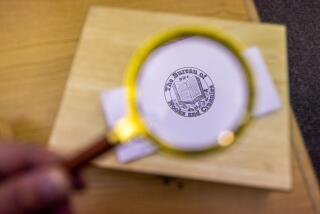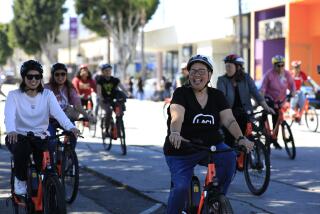At Teen’Scape, ‘MTV Meets L.A. Library’
- Share via
If 18-year-old Sarkis Dovlatyan could, he would live at the library. That’s because with a 50-inch plasma-screen television and DVD player in the “living room,” multimedia computers to surf the Internet and audio listening stations loaded with pop CDs, he figures, why go home?
“This is way off the scale,” said the Downtown Magnets High senior. “It’s like landing on Mars!”
That was the consensus opinion expressed Monday by area students as about 300 teenagers attended the Los Angeles Public Library’s unveiling of its newly enhanced downtown facility for youth, Teen’Scape.
After a $450,000 expansion, Teen’Scape boasts a “virtual library” featuring 19 online terminals allowing access to more than 500 electronic databases, glass-enclosed study rooms, a study lounge with eight computers with word-processing software, and a “living room” complete with fluorescent blue and green lighting and cushy armchairs and couches. At 3,780 square feet, the facility is triple its former size, making it one of the largest public teenager libraries in the country, library officials said.
“It’s like MTV meets L.A. Library,” said Robert Coffee, the architect of the new facility at the city’s main library, adding that many of the new features resulted from teenage focus groups. “[Libraries] have tried to fit teens in with children or adults, but they’re neither. . . . This space is something that they’re about.”
Devoted exclusively to teenagers--patrons who typically shy away from libraries--Teen’Scape opened in 1994 in a classroom-size area on the second floor of the Central Library.
Its shelves are still stocked with comic books, sports magazines and such titles as “The Rise and Fall of the American Teenager” and “Marx for Beginners,” a cartoon book on the philosophy of Karl Marx.
But while the library has proved popular over the years, library officials wanted to create a space that could hold the fickle attention span of teenagers growing up in the Information Age and often distracted by shopping malls, multiplex theaters and amusement parks.
“It’s difficult to get teens into a traditional library,” said library spokesman Peter Persic. “We knew that if we built it they would come.”
It took 18 months from design to construction, but for 13-year-old Yahneiqua Butler it was worth the wait. A music aficionado and Internet novice, she checked out the Web site of her favorite radio station: 92.3, The Beat.
“Yeah, baby,” said the Good Shepherd Middle School student as the site materialized on the screen. “That’s what I’m talking about.”
With eyes fixed on the monitors, teenagers next to her set up Yahoo e-mail accounts and played Mario Brothers at a video game Web site.
Meanwhile in the new study rooms, Celeste Torres, 18, flipped through the pages of Seventeen magazine. Her friend, Jon Oliveira, 17, thumbed a copy of the Guinness Book of World Records 2000 as his classmates relaxed on nearby couches with their legs flung over the edges.
“It’s high-tech and comfortable,” said Downtown Magnets junior Michael Fermanian as hip-hop music blared in the background. “It’s not like, ‘Shhh. Be quiet!’ It’s a party.”
Library officials said Internet filters will block inappropriate Web sites, such as those containing pornography.
Even before the enhancement, computers had attracted teenagers to the library. Teenage use of both computers and books has risen, library officials say. Teen’Scape computer use increased 26%, to 21,548 hours, from 1997 to 1998; circulation of adolescent reading materials jumped 27%, to more than 31,000 titles.
“Once they get into the library, they move from the computers into the books and magazines,” Persic said of the statistics.
It’s a move technology buff Sarkis Dovlatyan hopes to make on his next visit. He’s just itching to try the library’s automated device that will allow him to check out books by scanning the bar codes of his library card and books.
“I’m all into the technology, but it’s the books that are the important part.”


